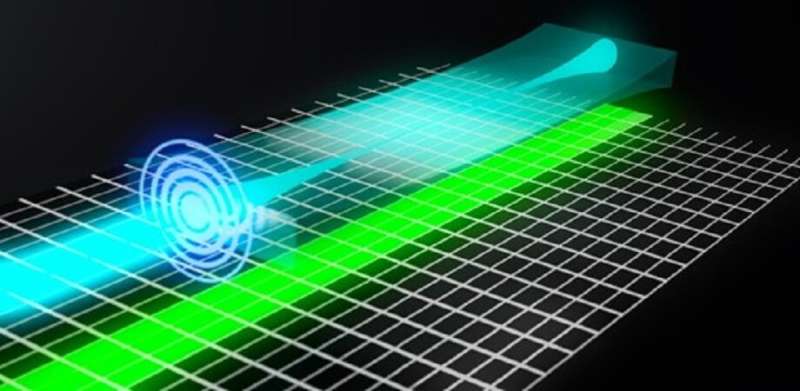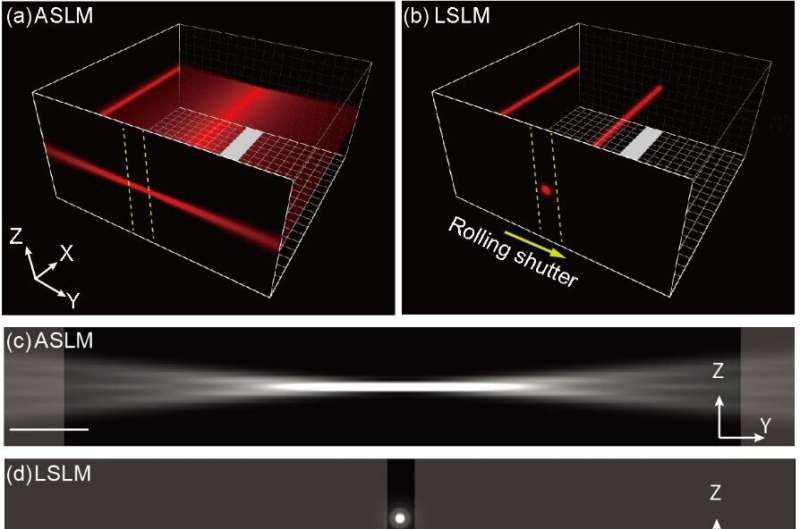Team develops photon-efficient volumetric imaging method with light-sheet scanning fluorescence microscopy

In biological imaging, researchers aim to achieve 3D, high-speed, and high-resolution, with low photobleaching and phototoxicity. The light-sheet fluorescence microscope (LSFM) helps meet that aim. Based on a unique excitation and detection scheme, the LSFM can image live specimens with high spatiotemporal resolution and low photobleaching. It has shown great potential for 3D imaging of biological samples.
The principle of LSFM technology is to illuminate the sample with a thin light-sheet and then collect the emitted fluorescence along the axis perpendicular to the transmission of the light-sheet. Therefore, only fluorophores close to the focal plane are excited and detected. Using a thinner light-sheet improves the axial resolution, while a longer light-sheet improves the field of view (FoV) and imaging speed. Tradeoffs are required, as it is difficult to generate a thin, uniform light-sheet.
Multiple light-sheets can be tiled to generate a virtual light-sheet with a higher aspect ratio. However, multiple beams also introduce sidelobes, decreasing the axial resolution and optical sectioning. Axially swept light-sheet microscopy (ASLM) uses a slit to reject the sidelobes. It uses the rolling shutter of the sCMOS, which naturally serves as a slit, to synchronize beam scanning. ASLM can image an arbitrarily large FoV with optimal axial resolution. However, the fluorescence signal outside the rolling shutter will be rejected, so a larger FoV comes at the price of lower photon efficiency.

A research team from the UTS–SUSTech Joint Research Centre for Biomedical Materials Devices recently developed a photon-efficient method to enlarge the FoV. As reported in Advanced Photonics Nexus, the team adopted a superresolution imaging technique, image scanning microscopy (ISM), to develop ISM-enhanced laterally swept light-sheet microscopy (iLSLM).
In iLSLM, a "light needle" is first generated by scanning a focused beam axially. When the image of the light needle is captured, pixel assignment is applied to generate a virtual thinner light-sheet. Afterward, the "light needle" is laterally scanned to form a complete light-sheet. Unlike the slit, the pixel assignment improves the optical sectioning and axial resolution without sacrificing photon efficiency.
The researchers found that both iLSLM and ASLM are much better than the conventional swept focus light-sheet (SFLM) in axial resolution and optical sectioning, and iLSLM outperforms ASLM when >55% photon efficiency is required. However, the current work of iLSLM is based on digital pixel reassignment, which significantly reduces the imaging speed. In the future, the researchers will explore optical pixel reassignment to achieve the same imaging speed as ASLM. Meanwhile, iLSLM will be suitable for applications where photobleaching is a severe problem, or the specimen is susceptible to phototoxicity.
More information: Liang Qiao et al, Laterally swept light-sheet microscopy enhanced by pixel reassignment for photon-efficient volumetric imaging, Advanced Photonics Nexus (2022). DOI: 10.1117/1.APN.2.1.016001
Provided by SPIE



















